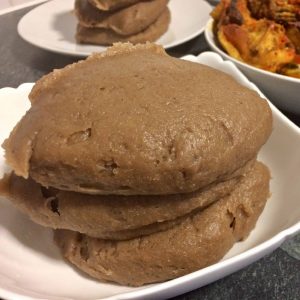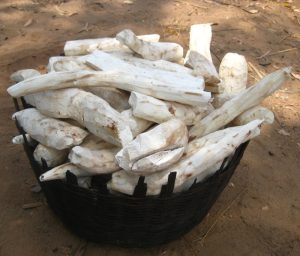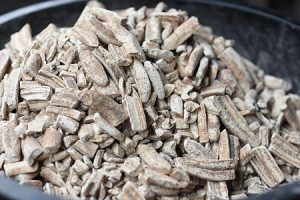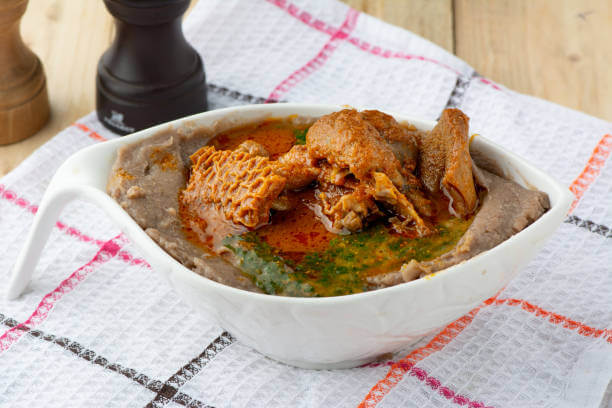Origin of Àmàlà

Àmàlà, a cherished Yoruba delicacy, has delighted people for ages. It holds immense popularity in Nigeria, serving as a staple main course. This blog post delves into Àmàlà’s origins, health advantages, and its significant role in Yoruba culture.
What is Àmàlà?
Àmàlà is a staple food in Nigeria, particularly in the southwestern region of the country. It is a Nigerian dish made from yam, cassava or plantain flour.
It is often served at social events and celebrations such as weddings, birthdays, and other important occasions.
Traditionally, Àmàlà is eaten with a variety of soups or stews such as ewédú and gbẹ̀gìrì (black-eyed beans soup), okra soup, ogbono or vegetable soup.

Origin of Àmàlà
Àmàlà was first prepared by Aduke Agbedegbeyo Omo Onile ire, Opomoja Ilekan Omo Yakooyo, Omo Alokolaro of Abule Onipaki in Atakumosa local government in Osun state in 1052 in the days when Sango was the Alaafin of Oyo and Oya was his wife.
However, it is believed that Àmàlà may have been developed as a way to preserve yam or cassava during times of scarcity. The preparation of amala involves a lengthy process of peeling, slicing, and grinding yam or cassava, which could help to extend its shelf life.

Types of Àmàlà
There exist three distinct variations of Àmàlà. The type obtained from yam is referred to as Àmàlà isu. Àmàlà’s derived from cassava is known as Àmàlà láfún. The final variant is obtained from unripe plantain and goes by the name of Àmàlà ògèdè.
Àmàlà isu and Àmàlà ògèdè are both popular types of Àmàlà flour, as they have a milder taste than Àmàlà láfún.
-
Yam flour (àmàlà isu): Àmàlà isu, the most common type of àmàlà, is yam-based. Tubers of yams are peeled, sliced, cleaned, dried and then ground into flour. It is also called èlùbọ́. Yams are white in colour but turn brown when dried which gives àmàlà its colour.

-
Cassava flour (àmàlà láfún): Àmàlà láfún is made from cassava flour. The root is peeled and washed, and dried. The dried cassava root is then ground into a fine flour.

-
Plantain flour (Àmàlà ogede): Another type of Àmàlà is elubo ogede, which is usually lighter in color. The low carbohydrate level in plantain flour makes it suitable for diabetics. Àmàlà Lafun is a rare type of Àmàlà flour, as it is more flavorful and has a stronger taste than the other Àmàlà flours.

Health Benefits of Àmàlà
The medicinal attribute of the food is attested to by a famous Yoruba saying: “Iyan ni onje, oka ni oogun, ki enu ma sile ni ti guguru’.” Translated to mean pounded yam is food, “Amala” is a medicine, popcorn is an appetiser).
The health benefits of Àmàlà include;
- Promotes healthy skin: Àmàlà is rich in antioxidants, which can help to protect the skin from damage caused by free radicals. Consuming Àmàlà regularly can help to promote healthy skin and prevent premature aging.
- Àmàlà is one of the good sources of minerals such as copper, calcium, potassium, iron, manganese, and phosphorus.
- Rich in carbohydrates: Àmàlà is a good source of carbohydrates, which are the body’s primary source of energy. Consuming Àmàlà can provide the energy needed to perform physical activities and maintain an active lifestyle.
- High in fiber: Àmàlà is high in dietary fiber, which can help to regulate bowel movements, improve digestion, and reduce the risk of colon cancer.
- Aids weight loss; Yam Flour is an effective weight loss aid. It has a high fiber content that helps to flush out waste from the body.
- Helps to manage Diabetes: Yam flour is a good meal for diabetic patients due to its low glycemic index, thus won’t cause a rapid rise in blood glucose levels of diabetes patients. This is so due to its ability to digest and absorb the carbohydrates in the yam flour slowly which helps to doesn’t cause a spike in the blood sugar/insulin levels.

Àmàlà & Yoruba Culture
In the Yoruba land, Àmàlà has strong cultural significance. Àmàlà is often served at special events and celebrations, as it is believed to bring good luck and prosperity.
Àmàlà serves as a profound connection bridging the Yoruba community with their abundant heritage. It transcends being a mere culinary delight; instead, it holds immense significance within Yoruba culture and customs. Àmàlà symbolizes the continuum of their history, present realities, and future aspirations, forging a sense of unity, affection, and resilience among the people. Through the tradition of cooking and eating Àmàlà, the Yoruba people honor their rich cultural heritage and express their pride in their identity.
ORISUN 2023!

Would you like to explore Nigeria’s culture, food, and social life in a safe and curated trip?
Last year we had our first Orisun trip to Lagos, Nigeria and this year we will be holding another trip.
Click here for more info!
Osun State – The state of the Living Spring

The State of the Living Spring History According to Yoruba tradition, Ile-Ife in Osun State is where the world’s creation began, orchestrated by Olodumare. This place symbolizes life’s start,…

